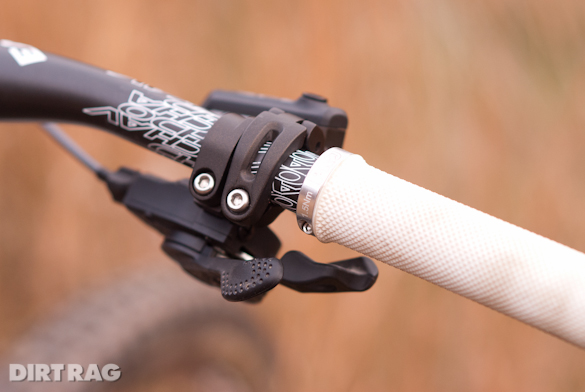Review: Shimano Zee group
Originally posted on March 5, 2014 at 9:33 am
Shimano’s redesigned Saint group has garnered much attention this year from those looking for the crème de la crème of Shimano’s gravity line. Fortunately for budget-minded shredders, Shimano trickled many of Saint’s technologies down to a new, mid-priced rival called Zee.
As with many of Shimano’s budget-friendly component offerings, Zee utilizes similar high-end technologies and designs, but keeps the price down by employing more affordable raw materials and construction methods. Relative to Shimano’s XC and trail group lineup, Zee fits in at about SLX-level in terms of fit and finish.
Brakes – $250/wheel (rotors and adapters sold separately)
Brakes are the business end of any gravity bike. As the saying goes, you can only go as fast as you can stop. Zee brakes borrow Saint’s master cylinder, caliper and lever design, replacing the reach and free-throw adjustment knobs with 2.5mm Allen bolts. Fortunately, Shimano’s new lever design is ergonomically stellar, making it easy to set up regardless. A dimpled lever surface adds a bit of grip in all the right places.
On the d-slope, the dual diameter, four-piston Zee brakes perform wonderfully, offering great modulation for subtle trail braking through corners while providing ample power when needed. Outright stopping power is said to be on par with the previous generation Saint brakes, but with better modulation. I believe it; these brakes offer a very linear, controllable and consistent feel. By utilizing pistons of different diameters, Shimano is able to provide more even pressure across the pad surface, which helps to minimize noise. These stoppers were dead quiet throughout the test, even when wet.

Like Saint, Zee’s finned ICE-tech pads dissipate heat to prevent both vapor (boiling of the mineral oil) and friction (overheating of the pad surface) fade. Throughout this test, I didn’t experience any fade in braking performance. I did, however, experience occasional brake pump as they heated up, but a quick release of the lever brought them back to the proper engagement point.
During Snowshoe Resort’s Chomolungma Challenge, a twenty-lap endurance downhill event, I was impressed by minimal pad wear. I had expected to chew through at least one set of brake pads during the race, but came nowhere close.
While $500 for a brakeset isn’t cheap, it’s $140 cheaper than a pair of Saint’s. Considering I wouldn’t be able to tell the difference between the two if blindfolded, Zee comes across as a bargain. If that wasn’t enough, Zee’s are only 18 grams heavier per wheel than Saint.

Crankset – $160
The Zee crankset is designed for 10-speed systems, and available in 68/73 and 83mm BB configurations—DH Press Fit is available as well. Crank lengths are available in the standard 165, 170 and 175mm options, with 34-, 36-, 38-tooth chainrings.
When it comes to single-ring cranksets, there’s not a whole lot to discuss; they work or they don’t. In this case, the Zee’s performed as expected. Steel pedal inserts bode well for both big hit abuse and longevity.
These cranks are a bargain, as they weigh just seven grams more than Saint, while commanding far less than half the price.

Shifter – $50 and Rear Derailleur – $110
Zee’s 10-speed shifter utilizes the same geometry as the Saint unit, including textured shift paddles. The primary functional difference is a single- vs. mutli-release action of the upshift trigger—with Zee you’re only able to shift to one smaller cog at a time rather than two with Saint.
The Zee group’s rear derailleur features Shimano’s Shadow Plus clutch system, but utilizes a more traditional parallelogram design—unlike the Saint’s wide and beefy structure. Stock, the derailleur will accommodate up to a 28-tooth cassette. An optional B-link (piece that connects the derailleur to the hanger) can be installed to allow for use with cassettes up to 36-teeth for 1×10 trail applications.
Zee’s shifting performance was a bit of a mixed bag on my initial test bike: Devinci’s Wilson SL (review in issue #167). With proper adjustment, this group shifted beautifully. With the clutch engaged, shifting feel at the lever required a little more effort, but performance was still great. Here’s the caveat. At the proper B-tension setting, the rear derailleur’s clutch mechanism clunked loudly on the chainstay. When I increased B-tension to minimize the clunking, shifting performance decreased, as you would expect.

Ultimately, I was never fully able to balance these interests on the Wilson. I could have good shifting with clunking, or mediocre shifting and no clunking. Eventually, I chose to eliminate clunking and deal with less-than-ideal shifting performance. However, with the Zee drivetrain set up as a 1×10 with an 11×36-tooth cassette on my Pivot Firebird, I had zero clunking issues and beautiful shifting performance. I was able to run a single chainring up front with no retention device and never dropped a chain during the test period.
There are a lot of factors here. Depending on frame design, some will be better or worse than others in this regard. It’s worth noting that both the Zee and Saint groups had interference issues on my Wilson. Given my flawless experience on the Firebird, this points to a bike-specific problem rather than a universal issue.
Final Thoughts
Shimano’s Zee group may be the little sibling of the high-end Saint line, but this “budget” drivetrain and brake package delivers performance that punches far above what its second-tier status might suggest. These are not budget parts, but rather components designed to better fit within the average rider’s bike budget. Overall, I’d say Zee delivers 90 percent of the performance of Shimano’s Saint group, at just 50 percent of the price. That’s hard to argue against, particularly for the awesome brakes. So long as you don’t experience derailleur-to-frame interference, drivetrain performance is top-notch, too.
Front and rear hubs are available as well for $70 and $90 respectively. Brakes, shifter, derailleur made in Japan. Cranks made in Malaysia.
